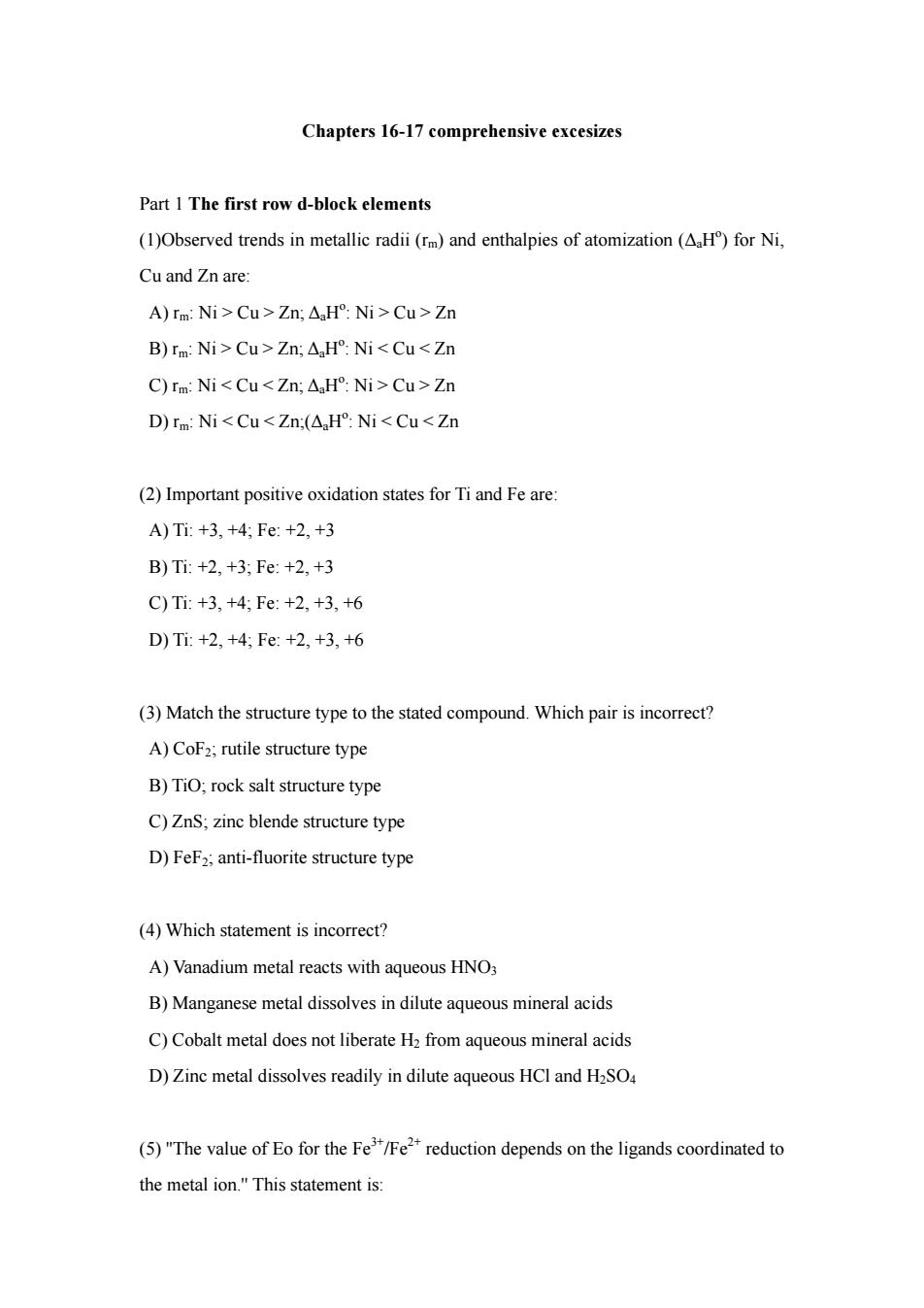正在加载图片...

Chapters 16-17 comprehensive excesizes Part I The first row d-block elements (1)Observed trends in metallic radii (m)and enthalpies of atomization (H)for Ni Cu and Zn are: A)rm:Ni>Cu>Zn:A,H:Ni Cu>Zn B)rm:Ni>Cu>Zn;A.H:Ni <Cu<Zn C)rm:Ni<Cu<Zn;A.H:Ni>Cu>Zn D)rm:Ni<Cu<Zn(AH°:Ni<Cu<Zn (2)Important positive oxidation states for Ti and Fe are A)Ti:+3,+4Fe:+2,+3 B)Ti:+2,+3;Fe:+2,+3 C)Ti:+3,+4:Fe:+2,+3,+6 D)Ti+2,+4:Fe:+2,+3,+6 (3)Match the structure type to the stated compound.Which pair is incorrect? A)CoF;rutile structure type B)TiO;rock salt structure type C)ZnS;zinc blende structure type D)FeF2;anti-fluorite structure type (4)Which statement is incorrect? A)Vanadium metal reacts with aqueous HNO3 B)Manganese metal dissolves in dilute aqueous mineral acids C)Cobalt metal does not liberate H2 from aqueous mineral acids D)Zinc metal dissolves readily in dilute aqueous HCl and H2SO (5)"The value of Eo for the Fe"/Fe2reduction depends on the ligands coordinated to the metal ion."This statement is: Chapters 16-17 comprehensive excesizes Part 1 The first row d-block elements (1)Observed trends in metallic radii (rm) and enthalpies of atomization (ΔaHo ) for Ni, Cu and Zn are: A) rm: Ni > Cu > Zn; ΔaHo : Ni > Cu > Zn B) rm: Ni > Cu > Zn; ΔaHo : Ni < Cu < Zn C) rm: Ni < Cu < Zn; ΔaHo : Ni > Cu > Zn D) rm: Ni < Cu < Zn;(ΔaHo : Ni < Cu < Zn (2) Important positive oxidation states for Ti and Fe are: A) Ti: +3, +4; Fe: +2, +3 B) Ti: +2, +3; Fe: +2, +3 C) Ti: +3, +4; Fe: +2, +3, +6 D) Ti: +2, +4; Fe: +2, +3, +6 (3) Match the structure type to the stated compound. Which pair is incorrect? A) CoF2; rutile structure type B) TiO; rock salt structure type C) ZnS; zinc blende structure type D) FeF2; anti-fluorite structure type (4) Which statement is incorrect? A) Vanadium metal reacts with aqueous HNO3 B) Manganese metal dissolves in dilute aqueous mineral acids C) Cobalt metal does not liberate H2 from aqueous mineral acids D) Zinc metal dissolves readily in dilute aqueous HCl and H2SO4 (5) ''The value of Eo for the Fe3+/Fe2+ reduction depends on the ligands coordinated to the metal ion.'' This statement is: 1